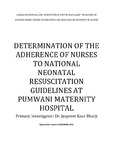| dc.description.abstract | Background and significance:
MDG4 targets a reduction in the Under 5 year Mortality Rate (U5MR) by two thirds
between 1990 and 2015 and it has been noted that neonatal deaths are becoming a
greater portion of the total under 5 mortalities. Globally, 3-6% of neonates require
basic resuscitation and it has been demonstrated that basic resuscitation of newborn
babies can lead to a 6-42% decrease in neonatal deaths. Kenya as a country
has developed guidelines on neonatal resuscitation in an attempt to save as many
neonates as possible. Our aim was to assess if these protocols were indeed
correctly being put into practise at Pumwani Maternity Hospital (PMH). Objectives:
Our primary objective was to determine the level of adherence of nurses to the
National neonatal resuscitation guidelines at PMH.
Methodology:
We carried out a cross sectional survey at PMH over a period of three months. This
involved determining the availability of basic equipment required for neonatal
resuscitation at PMH as well as an analysis of the knowledge and practices of the
nurses of neonatal resuscitation.
Results:
Of the 140 resuscitations observed in three locations at PMH (labour ward, maternity
theatre and newborn unit), the National guidelines were only adhered to in 39%.
Three quarter of the resuscitations were observed during the day while the
remainder were observed at night. When analysed according to the different steps of resuscitation, the guidelines were
adhered to in 71.4% of the resuscitations in preparation, drying and warming, 63.6%
in airway and 39.3% in breathing.
The most poorly performed steps were correct suctioning in the presence of
meconium (52.5%), calling for help (67.1%), giving the correct number of inflation
breaths (56.4%) and achieving adequate chest rise during ventilation (73.5%).
Adherence to guidelines was better in the new born unit (OR 3.75, p=<0.001), when
all resuscitation equipment was available (OR 2.74, p=0.004), in cases of
resuscitation of preterm neonates (OR 0.18, p=<0.001) and neonates less than 2500 grams (OR 0.37, p=0.008).
Resuscitation equipment was fully available in 57% of the resuscitations with the
shortage of two dry towels for each resuscitation being the major gap.
Only 57.1% of the 35 nurses attained ≥50% on the knowledge assessment.
Knowledge was poorest in the following areas: identifying preparation as the most
important step in resuscitation, correct number of inflation and ventilation breaths,
knowing when to initiate chest compressions, use of oxygen in resuscitation and the
frequency of assessing the neonate during resuscitation.
Conclusion:
Of the 35 nurses observed 5.7% adhered to the National guidelines with 39% of the
140 resuscitations being carried out well. | en_US |
| dc.description.department | a
Department of Psychiatry, University of Nairobi, ; bDepartment of Mental Health, School of Medicine,
Moi University, Eldoret, Kenya | |

